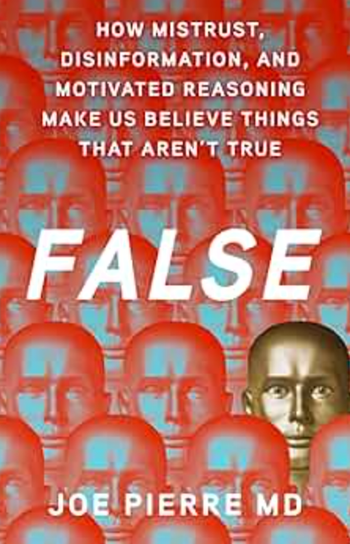
Anti-Semitism and Psychiatry: Recognition, Prevention, and Interventions
Conceived as a needed sequel of Islamophobia and Psychiatry, this volume reflects not only the intellectual cogency and scholarly vision of its Editors but also a solid presentation of multiple perspectives on a complex social phenomenon.
BOOK REVIEW
Accurately introduced as “the first book of its kind in one generation,” and conceived as a needed sequel of
The first chapter in Part I (General Issues) is an illustrative example of this outreach. It deals with the history of Judaism and Anti-Semitism, describing the original Israelites from around 2000 years before the Christian Era, their succeeding conflicts with Egypt and the Greeks, and the first documented evidence of Anti-Semitism by Manetho, a 300 BCE historian who wrote an Exodus story very different than the Bible’s version, and established the Jews as “impure and impious,” “brutal and tyrannical.” Being both “part of and apart from the wider cultures,” but distant from modern notions of pluralism, Jews became an arrogant minority in the view of the other ethno-demographic groups of their time. The subsequent emergence of Christianity and its unique variety of Anti-Semitism, born out of the forever conflictive version of Jews’ management of the life and death of Jesus, the subsequent Christian “super-secessionism” or “replacement theology,” the historical suffering result of “God’s punishment,” the Crusades and the Inquisition as the “blurring of the line between mob action and official Church-sanctioned policies” led to the horrors of
I have devoted a more or less extensive paragraph to this first chapter not only for its excellent informational structure but also because it offers a most adequate background for many of the other contributions. Such is the case of Chapter 2 on Prejudice, which identifies ethnocentrism and xenophobia as driving forces of Anti-Semitism, lack of empathy and cognitive dissonance, absolutism, and ignorance as its psychodynamic mechanisms. Catholic perspectives (Chapter 3), including the redeeming role of the
As this review progresses, it becomes clear that the book’s structure responds primarily to a basic editorial need and does not establish neat topical distinctions. Thus, a reader may prefer focusing on larger, more inclusive aspects, as done above with what could be called a socio-geographic approach. The same view presides the examination of three unique aspects of Anti-Semitism that could be named biological, artistic, and ideological. The first is examined in Chapter 4 by describing the neurobiological determinants of features that, in one way or another, are reflected in Anti-Semitism. After going through ancient phylogenetic roots to the perception of out-groups, and showing a fascinating list of brain locations, the author correlates them with dehumanizing aspects of human behaviors such as Anti-Semitism, and the complexity of a threatening perception of “the others.” Chapter 5 offers an artistic view of Anti-Semitism, the author using the symbolism of drawing and painting as the compass of his experience facing Anti-Semitism and suggesting the healing power of art; this point is more explicitly made in Chapter 24 with the presentation of the “colossal” therapeutic power of film and storytelling as relevant-and challenging-tools of insightful healing.
The ideological component of Anti-Semitism cannot be examined without considering psychoanalysis, the clinical doctrine that for decades was mostly identified as “Jewish,” the life, work, friends, and adversaries of its founder, and the impact of its explanations about hatred-inspired behaviors. Several chapters throughout the book deal with these issues. The circumstances of the involvement of the Swiss and Christian/Protestant Carl Jung with the relatively new Viennese and all-Jewish psychotherapeutic movement, Freud’s agenda related to his chosen “Crown Prince,” the reaction of the Founder’s inner circle, Jung’s subsequent exclusion and his equivocal or, at least, ambiguous association with Nazi organizations are well-documented fascinating material, particularly in Chapters 7, 13, and 14. A long list of leading figures (eg, from Szasz to Bettelheim, Frankl to Erikson, Kernberg to Kohut) of European psychoanalysis and psychiatry, mostly located in post-WW II America, and the beneficial and sometimes damaging effect of their work on patients and communities are also the subject of sound examinations.
By and large and not unexpectedly, clinical perspectives on Anti-Semitism occupy several Chapters of Parts II, III, and IV. There are provocative statements like the closing phrase of Chapter 6, called “an outrageous contradiction” by the author himself. The topic of Jewish identity expressed as source of pride, ironic resignation, furious objections, or bitter responses to critics, occupies a good number of pages throughout. Specific clinical challenges regarding Anti-Semitism are dealt with by means of diagnostic discussions that go from genetic pronouncements to fanaticism-related adjectives through individualized symptoms such as lack of empathy, dissociation, intolerance, stigmatizing practices and the intriguing inter-generational transmission. Interestingly, personality disorders are barely mentioned. As far as management goes, transference and countertransference reactions are capably dissected beyond psychoanalytic boundaries in Chapter 16, to include much-needed cultural psychiatry-based concepts.
Contemporary Jewish communities counter Anti-Semitism by means of different strategies: responsive, proactive, collaborative activities; reinforcement of consensus-building relational approaches (regrettably weakened by purely political maneuvers within and outside Israel); fight against silence and complicity and against the “malignant morality” denounced by Robert Jay Lifton. The need to strengthen the ethical basis of these strategies is well stated as is the intrinsically powerful value of attitudes like “We refused to hate,” the title of Chapter 27 authored by a Muslim psychiatrist.
The last chapter of this book has the title “Is there a cure for Anti-Semitism?” Together with the Editors’ Conclusions, it serves as adequate epilogue of a precious publication. It summarizes the preceding contents and examines different angles of Anti-Semitism, its ups and downs in the world’s scene, conspiracy theories against Jews and Judaism, the essence of an evil ideology that, paradoxically, has generated in the target population high levels of posttraumatic growth and renewed chai (life) and chutzpah (audacious resilience). While recognizing that psychiatrists “have had at best a mixed track record” in addressing social concerns, the chapter faces the dilemma of whether Anti-Semitism is a mental disease, tentatively concluding that it is indeed a “social pathology rather than an individual illness,” a “unique hatred” of cyclical occurrence; nevertheless, attempting to put it under Freud’s early notions of “psychopathology of everyday life” seems, to this reader, a risk-charged nosological simplification.
A metaphoric use of the Middle Age European term “potluck” (a combination of a variety of nutritional ingredients brought in by different family members for the preparation of the gathering’s main meal) assists the author to delineate a series of management interventions, a comprehensive set of therapeutic measures for Anti-Semitism. The obstacles are not small, of course, but tenacity, compassion and openness, integrated care, research contributions, eventual use of psychopharmacological agents, and the materialization of a “multipronged global endeavor” can help to weave a genuine “tapestry . . . (capable to) . . . withstand wear and tear. . . .”
It is difficult to summarize the central impressions left by the reading of Anti-Semitism and Psychiatry. It is a book full of stimulating questions, ideas, perspectives as well as debates and polemics. It offers a multi-faceted set of options, a creative view of “otherness,” a hopeful sense of the future. Beyond an inevitable repetition of some concepts, eventual contradictions or occasional rigidities, this reviewing experience has reminded me continuously of two of the many things I learned from
Disclosures:
Dr Alarcón is Emeritus Professor of Psychiatry, Mayo Clinic School of Medicine, Rochester, MN; Honorio Delgado Chair, Universidad Peruana Cayetano Heredia, Lima, Perú.
Newsletter
Receive trusted psychiatric news, expert analysis, and clinical insights — subscribe today to support your practice and your patients.




